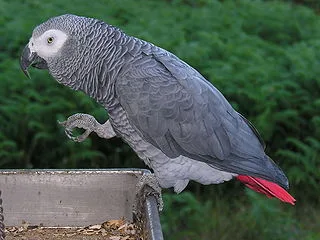
Grey Parrot
[order] PSITTACIFORMES | [family] Psittacidae | [latin] Psittacus erithacus | [authority] Linnaeus, 1758 | [UK] Grey Parrot | [FR] Perroquet gris | [DE] Graupapagei | [ES] Loro Yaco | [NL] Grijze Roodstaartpapegaai | [copyright picture] L.Miguel Bugallo Sanchez
Subspecies
| Genus | Species | subspecies | Region | Range |
| Poicephalus | erithacus | |||
| Psittacus | erithacus | AF | w, c | |
| Psittacus | erithacus | erithacus | se Ivory Coast to Kenya, Kenya, Tanzania and Angola, and islands in the Gulf of Guinea | |
| Psittacus | erithacus | timneh | s Guinea to Sierra Leone, Liberia, Mali and w Ivory Coast |
Genus
The African Grey Parrot (Psittacus erithacus), also known as the Grey Parrot, is a medium-sized parrot found in the primary and secondary rainforest of West and Central Africa. Experts regard it as one of the most intelligent birds.
Physical charateristics
An unmistakeable mottled grey, medium-sized parrot. It has a large black bill and white mask enclosing a yellow eye. Has a striking red vent and tail. Subspecies P. e. timneh is darker than the nominate, with some red on the bill, and its call is distinctive.
Listen to the sound of Grey Parrot
[audio:https://planetofbirds.com/MASTER/PSITTACIFORMES/Psittacidae/sounds/Grey Parrot.mp3]
Copyright remark: Most sounds derived from xeno-canto
recorded by unknown
| wingspan min.: | 0 | cm | wingspan max.: | 0 | cm |
| size min.: | 28 | cm | size max.: | 39 | cm |
| incubation min.: | 21 | days | incubation max.: | 30 | days |
| fledging min.: | 75 | days | fledging max.: | 85 | days |
| broods: | 1 | eggs min.: | 1 | ||
| eggs max.: | 3 |
Range
Africa : West, Central. Africa : West, Central. Present with two subspecies in several countries of central and central-western Africa. Psittacus erithacus has a distribution extending from Guinea-Bissau east through the moist lowland forests of West Africa to Cameroon, and thence in the Congo forests to just east of the Albertine Rift (up to the shores of Lake Victoria) in Uganda and Kenya and south to northern Angola.
Habitat
Generally lowland most forest, both primary and secondary, including edges and clearings, and also at times occuppying mangroves, gallery forest, savanna woodland, cultivations. Strongly associated with oil-palms for food.
Reproduction
Yhe nest is built in a tree hollow or cavity. The Bourke’s Parrot has a clutch of 3 to 6 eggs, which are incubated by the female for 18?19 days, with the chicks fledging at about 4 weeks of age. The female also feeds and tends to the chicks by herself. While the female Bourke’s Parrot is incubating the eggs, and also while she is feeding the chicks in the nest, she is fed by the male.
Feeding habits
They feed on seeds, nuts, fruits and berries gathered mostly in the treetops. When feeding they usually climb from branch to branch, rather than flying, and will hold the fruit or nut in its foot to eat. Grey Parrots are especially fond of eating the outer oily flesh of the oil-palm nut. They also prefer the red fruits of the Cola tragacantha, when available being careful not to eat the stone. They have also acquired a fondness for grain, and in West Africa they do immense damage to maize crops.
Video Grey Parrot
httpv://www.youtube.com/watch?v=DRZPhwjZgC0
copyright: Josep del Hoyo
Conservation
This species is listed as Near Threatened because a recent analysis suggests that up to 21% of the global population may be harvested annually. In combination with the rate of ongoing habitat loss, the species is therefore suspected to be declining moderately rapidly.
It suffer to some degree from forest destruction, especially loss of large nesting trees. More importantly, one of the most heavily traded parrot (in period 1982-1989, 47,357 birds). In ome countries (e.g. Liberia) the decrease of population due to trade was dramatic. Captures for trade is the major cause of breeding failure in some populations.
It suffer to some degree from forest destruction, especially loss of large nesting trees. More importantly, one of the most heavily traded parrot (in period 1982-1989, 47,357 birds). In ome countries (e.g. Liberia) the decrease of population due to trade was dramatic. Captures for trade is the major cause of breeding failure in some populations.

Migration
Resident, although in some areas the presence is related to the availability of fruiting trees (e.g., Kibaler Forest in W Uganda). At least in West Africa, the species makes seasonal movements out of the driest parts of the range in the dry season
Distribution map

